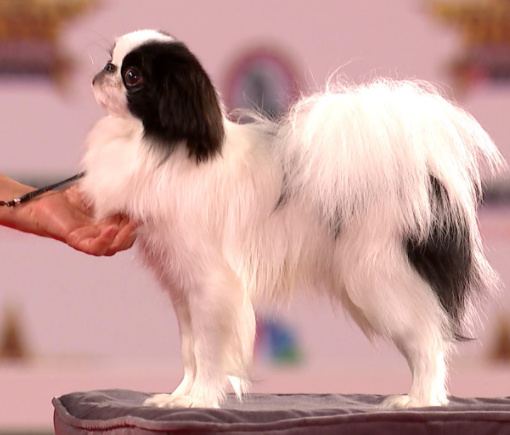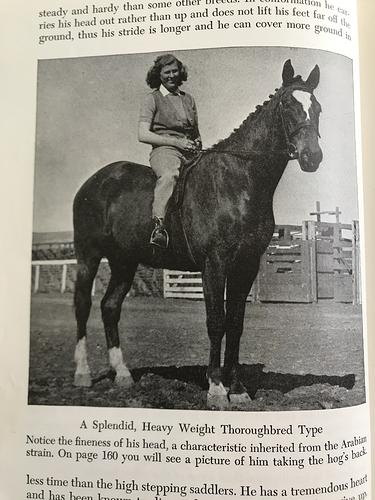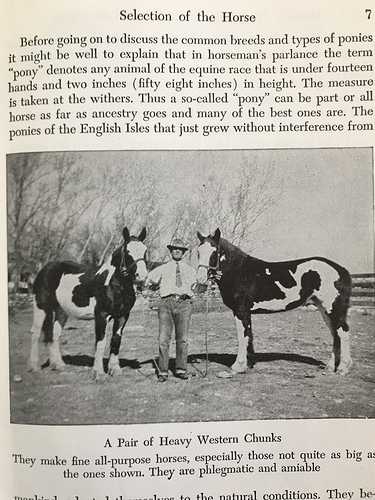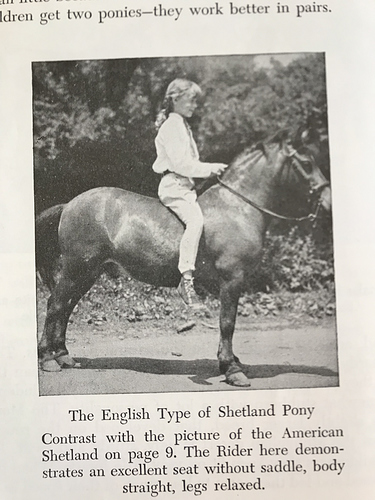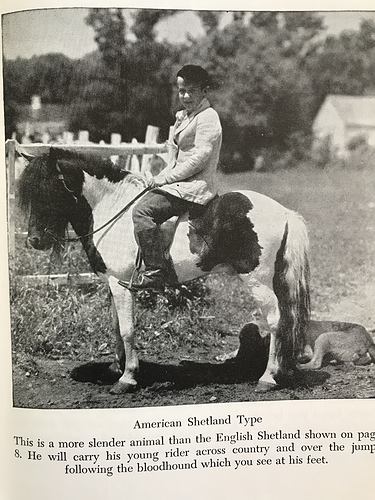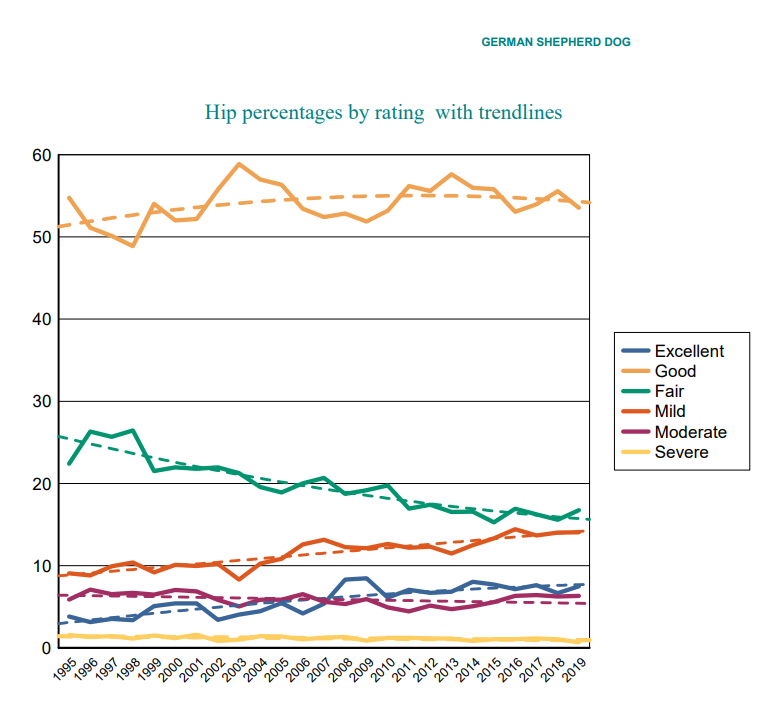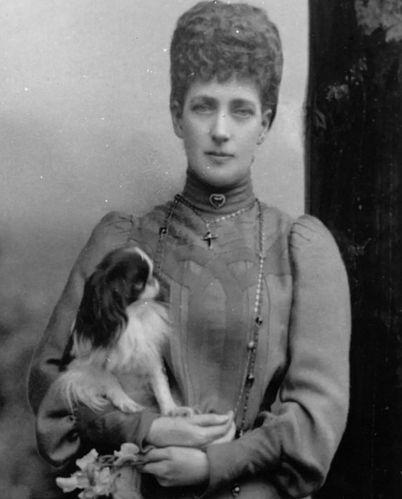We have an old book given to me by my grandma. She recently passed away. She was the source of my love for horses and everything about living on a farm. Anyway, this book was written in the 1940s and has few breed pictures of horses I would love to own. What have we done to our horses? Look at this lovely TB type. Those legs and feet look so much different than our modern TBs and TB crosses.
I don’t know what the modern equivalent of a Western Chunk is, but I’d love one of those kind looking horses as a husband horse.
And these ponies! The first one is beautifully proportioned and the second looks like a great babysitter type.
All of these pictures are from Horses, Their Selection, Care and Handling, by Margaret Cabell Self, published in 1943.
I have the same book, I recognize these photos! So cool to see. Things have definitely changed.
Great pics!
Yes, just like dog breeders, horses get “refined” to meet the current standards of Show Worthy.
Tiny QH feet, Schwarzenegger Halter horses, TBs built to runlikemad as Not-Really 2yos, WBs with exaggerated movement, Arabs with faces so dished it’s painful to look at, etcetera & ad nauseum.
…zips on flamesuit… 
Well…the book even identifies the horse as a “heavy weight thoroughbred type”. So it suggests that even at that time there were other types of TBs. And maybe this “heavy weight” type wasn’t typical either…did this horse actually race?
Sure, but that doesn’t mean that all dogs or horses look like the “current standards” or the photos in the book. Lots of dog breeds haven’t really changed much. But you can always find at least one old and one current photo that make it appear that they have changed dramatically. I suspect the same is true of horses.
I don’t know…I think people worked their horses harder back then and they had to stand up to that work. I don’t think there were as many horses just sitting in pastures.
I do think many of the hunting dog breeds have changed quite a bit. They were used for hunting more. Now, it seems like there are two groups of the same breed. We have a field bred English Springer Spaniel that is intelligent, responsive, and driven. Not at all like the show spaniels we’ve met. Don’t Labradors have working field dogs and bench/pet types? They have changed a lot. Popularity can drive a dog breed to extremes. Look at GSDs as well.
With horses, yeah, halter stock breeds and extreme halter bred Arabians come to mind, but I think many breeds are guilty of sacrificing form and function for a show ring ideal.
My grandma had an old pamphlet from Bask and several of his sons that were standing stud at one point. She loved the idea, but never did breed her Mustang mare to one of those boys. I’m not even sure they would have accepted non-Arabian mares. Back then, Arabians gave horses ‘refinement’, so many people tried to breed their stock mares to Arabian stallions. I wish I still had that pamphlet. Beautiful horses. Grandma ended up taking her mare to a TB breeder. The filly was lovely, actually.
Oh wow, I just looked it up and Bask was standing stud in the US in the 1960s, apparently. His stud fee was $500. That pamphlet was old when I found it tucked into that old horse book.
So I grew up at the low end of horse in the 1970s. Most horses were grade, and many of our horses came through a local dude string that bought off auction and wildies from First Nations land. There were some truly fugly but beloved kids horses around. The actual breeds if you wanted to get fancy were Appaloosas (some nice ones) and half Arab. Despite our proximity to a race track, no one in my circle was buying OTTB. They were thought to be too hot. Most riders were unsupervised teens, no coaches or trainers, and only one barn had an actual arena. We had so much fun.
As a returning rider for the past 15 years I am at the low end of nice horses. I get to see a lot of project horses, fallen through the cracks horses, OTTB, OTSB, WB, as well as QH, Paints, Arabs or crosses, Iberians, Friesian crosses, etc.
So from my vantage point, horses today are much nicer than 45 years ago! They also live much longer healthier lives.
It’s true they also break down, but my observation is that it’s the horses who are only ridden in the indoor arena and drilled repeatedly that break down. Yes, you can break down a horse before it is confirmed First Level dressage, if you do enough spur and crank.
A book like this is a misleading glimpse into the past because the author has chosen nice examples to prove her point.
My guess is TB type is a crossbreed. Also there are certainly horses today that look like Western Chunks. They are being bred for ranch work and especially for pack and hunting outfitters. They can be QH crossed with Belgian, Percheron, or Fjord, depending on how big a horse you want.
Agree.
But some breeds - destined for show only - have been overbred into parodies.
Irish Setters used to be intelligent dogs…until somebody decied a narrow skull (= smaller braincase) was desirable.
German Shepherds did not have the problem with dysplasia before a lower-set hindquarters was bred in.
Labradors had size, show dogs are dwarfed by comparison.
Bulldogs & all the flatfaced breeds… 
Same for the overbred, intended for showring horse breeds.
Thanks for a different perspective. It’s hard to know what horses looked like in the past. I do have some pictures of my grandma’s horses and they were better built than many I see when horse shopping, but that could have been that my grandma had a good eye for conformation.
My great grandfather also bred racing QHs up in Oregon. He had some absolutely beautiful horses. His pictures showed well balanced, powerful, but not bulky, athletic animals. I haven’t seen horses like his in a long time.
Funniest thing is that years after he died, my first mare came from a rundown old farm, cheap (she had bad habits). She had papers that showed she was the great granddaughter of one of my great grandfather’s old horses! Completely random chance. He wasn’t a big breeder. I didn’t even see her papers until we bought her. That mare had heart to spare. Tried everything I asked of her (once we got through the bad habits). She was fast, too. Always needed her sprint. I picked out a safe spot for her runs on the trails we commonly rode. She lived to be 34 years old.
I don’t think we’ve lost all good horses, by any stretch. I guess it just seems like there are a lot more poorly bred horses now than there were back then. I think there are far more soundness issues because they disposed of lame horses pretty quick back then. I think they paid more attention to form and function, even their backyard horses. At the low end, I don’t know how much a pretty head played into those traits if animals were selected more for soundness than anything. Perhaps more horse breeders were male and less concerned about anything other than working ability. Professional packing trips, ranch work, dude ranches…those jobs just aren’t as common. It’s getting harder to find a good lesson barn. So many have closed or the land is developed.
Our backyard horses held up to all kinds of mountain trails and bombing around. But few of them had the conformation to be competitive in anything, and none of them came with any schooling. Jumpers started at 3 feet, no crossrails class. Gaming horses were ferocious, there was no tier system in barrels so you wouldn’t work your way up from trot D. Dressage did not exist, people went in rail classes to show flat, the QH and part Arab cleaned up in Western Pleasure.
We had a fun series of local play day mixed schooling shows that anyone could dress up and boop around in. Then there was a huge deal multi day multi discipline show at the annual Pacific Nations Exhibition ground. A few of girls from the fancy barn with the arena and Arab crosses might have made it there a few times.
My point being that good using horses bombing around trails with 99 pound teens don’t tend to break down but they also don’t have any special talents.
On FB I’m constantly getting posts from a person up country who is marketing First Nations feral yearling “wildies” as rescues. I am so not tempted. I expect they can grow up to be good trail horses but I want more even in a trail horse.
Interesting question about whether the pictured TB even raced. I decided to look for a picture of Whirlaway, a champion TB of the 1930s and '40s (won the Triple Crown), and to find some pictures of him “racing fit”. Here’s link to what I found:
Whirlaway
What I see in those photos is a well-built, solid-boned horse.
But this doesn’t actually exist. There are no breeds “destined for show only.” Yes - many breeds are split with “show lines” and “field lines”. There still are breeders that breed Irish Setters for hunting, not show, as well as many other breeds.
But what you think about GSDs and dysplasia is likely not the case. “Lower set hindquarters” = over-angulated hocks. It is not connected to hip structure and function. Hip dysplasia is genetic, and many breeds and crosses are prone to it - regardless of whether they are bred for show or not. The key to eliminating it is testing for it, and breeding it out.
It’s easy to fall into the mindset that show breeders are at fault; but realistically - dogs who are bred for specific reasons are more likely to be tested for congenital issues, and dogs with issues are eliminated from breeding programs. The backyard breeders that don’t test and/or don’t breed to any standard are likely contributing to the problem more than people realize.
FYI, these are the hip dysplasia stats for GSD over the last 20+ years as per OFA. It’s hard to interpret what it means…e.g. “fair” is declining and “mild” is increasing…not sure of why. Maybe more tests being conducted, maybe a change at OFA about how to read/score them…? Generally speaking, though - the severe cases look stable and the good ratings look fairly stable. An increase in Excellent ratings is great to see.
My mentor has been breeding Labradors forever. She gets JH titles on her dogs as she believes it’s important to keep breeding for those instincts. She has had some dogs that could hunt all day, but most are lower key.
As far as conformation, she said (paraphrasing here), that in England the dogs were bred to be short and stout to be able to push through the dense brush, and they didn’t have to travel long distances. In the US, we have a lot more open area, so the dogs used for hunting were bred away from that standard to be longer legged, and lighter.
In the 70’s we had some ponies with god awful conformation. One paint pony had severe navicular by age 8, and a neighbor had a boarder who lived there most of his life after being retired young due to navicular. He was QH. Was that from genetics, or poor hoof care? No way to know.
I’m not necessarily disagreeing with you because I’ve only been riding since the early 90s so I’m not sure how “back then” I can comment on, but don’t you think we might also have higher standards for soundness these days? Not everyone does obviously, but overall it seems like there’s more attention to subtler issues that I don’t remember hearing about even in the 90s or early 2000s, like Lyme, ulcers, kissing spine, etc. The diagnostic tools have become much more wide-ranging, sensitive, and available too so maybe we’re more likely these days to go looking for and find a physical problem underlying training/behavior/NQR issues rather than just writing the horse off as difficult.
As to the OP, based on that photo and without having seen the book, I suspect “Thoroughbred type” was shorthand for a light riding horse, not a pedigreed/registered TB. That one looks like maybe a TB-draft cross? Totally unscientific but if you Google Image search “1930s thoroughbred racehorse” the results are all recognizably TB-looking to my eye.
Thanks for correcting me re: Shepherds & Labs.
However ( here it comes…), can you deny the apple-headed breeds have been made to not only look totally different than the originals, but physically deficient as well?
here it comes…), can you deny the apple-headed breeds have been made to not only look totally different than the originals, but physically deficient as well?
Makes me sad to see these breeds struggling with the very act of breathing.
I would agree with that.
I would also speculate that a hundred years ago, culling of unsound horses was favored more often, compared to today. With current medical technology, we have a lot more options to try and fix horses.
My point is that you cannot tell whether this is actually a change in how the breed looks by comparing two photos. You can always find a terrible specimen to show as a representative about how things have become terrible.
In comparing these two pictures of a Japanese Chin (a breed I would call “apple headed”) - I think that time has improved things (1904 v. 2019). Or, is the old photo a poor specimen? You would need to be an expert in the breed to know.
